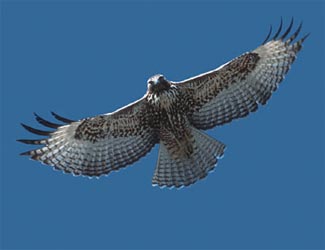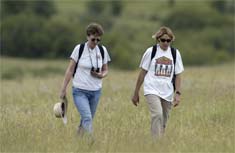The Zumwalt Praire Reunion

Above the prairie bunchgrass, a red-tailed hawk screeches. Its cry rolls across the grassy hills and back into the memories of two women standing together with binoculars pointed toward the sound. The two women, Marcy Houle and Pat Kennedy, have followed hawks for much of their lives, a passion which has led them by separate paths to this place, the Zumwalt Prairie.
In the remote northeast corner of Oregon, the Zumwalt Prairie is an undulating grassland, home to cattle ranchers, elk herds, early winter snows, and one of the highest concentrations of hawks in North America.
As a graduate student at Oregon State University during 1979 and 1980, Marcy Houle studied hawks in the Zumwalt Prairie.
Initially the study was to be a simple measuring of hawk nest heights, a straightforward analysis that would yield a straight-forward master’s thesis. But Houle wanted to do more. Her advisor, Dr. Charles Warren, inspired his graduate student to look at the whole Zumwalt system: the hawks, the people, and the prairie. It was known that nesting hawks were especially plentiful here. Marcy’s charge was to find out why.
Now, a quarter century later, Pat Kennedy, an OSU wildlife biologist, is repeating parts of Houle’s graduate study, returning to nesting sites documented 25 years earlier, to see how the hawks of the Zumwalt Prairie are faring.
 |
 |
|
|
As a graduate student at OSU 25 years ago, Marcy Cottrell Houle was the first to document that the Zumwalt Prairie had one of the highest concentrations of nesting hawks in North America. |
Red-tailed hawks are among the most abundant birds of prey on the Zumwalt Prairie, where their diet consists primarily of Beldings ground squirrels. Photo: Jerry and Sherry Liguori |
The new study is a homecoming in more ways than one. After Kennedy joined the faculty at OSU’s Eastern Oregon Agricultural Research Center in 2002, she became interested in this remote corner of Oregon and its population of hawks. As it turns out, during the 1970s, Houle (whose name was Marcy Cottrell back in those days, before she married) and Kennedy had been biology students together at Colorado College. There they had both become entranced with studying hawks. Cottrell had followed her passion to remote parts of Colorado and to the Zumwalt, before finding her career as a writer. Kennedy went on to become a university professor and leading expert on North American hawks. The two women had not seen each other since their college days until they reunited in 2003 at the Zumwalt Prairie.
The Zumwalt Prairie is a remnant of the Palouse, the fertile, windswept plateau that forms much of eastern Washington’s richest wheatlands. The Zumwalt Prairie, named for an early pioneer family, is tilted higher than the rest of the Palouse and is isolated by the looming height of the Wallowa Mountains and the precipitous depth of Hell’s Canyon. Unlike the wheatlands to the north, this prairie, encompassing 220 square miles, is still swathed with native bunchgrass, wooded canyons, aspen groves, and spring-fed meadows. Grazing cattle share the prairie with elk, mule deer, and lots of hawks. Broad-winged buteo hawks, such as red-tailed, ferruginous, and Swainson’s, share the skies with golden eagles and prairie falcons.
 |
 |
|
|
Swainson's hawks, such as this one, soar over the Zumwalt Prairie. Photo: Jerry and Sherry Liguori |
Kennedy's new study will examine how the Zumwalt landscape may be changing, as aspen disappear and pines encroach into the prairie. Photo: Michael Durham |
The prairie’s pristine condition and its abundance of wildlife caught the attention of The Nature Conservancy, which purchased 42 square miles of the Zumwalt and adjacent Imnaha canyon in 2000, the largest single acquisition by TNC in Oregon. But prairie conservation has been a way of life for many ranching families.
“My guess is that more than half of the land up there is still owned by the original pioneer families,” said John Williams, chair of the Wallowa County office of OSU Extension and a natural resources specialist. “For a long time, it’s been a culture of neighbors helping neighbors, where wisdom is passed down through the generations.
“In the Zumwalt Prairie, there were early pioneers with a good sense of range management,” Williams said. “The country is too high to support cattle through the winter, so most ranchers rotate their livestock. They didn’t let the grassland get run down like so many other bunchgrass prairies throughout the West. They kept track of the condition of their grass. They didn’t let cows camp out in a draw bottom. They maintained the right number of animals for the forage available each year.”
In her research, Houle got to know some of the ranching families of the Zumwalt prairie as she surveyed the three species of buteo hawks. At the time, populations of ferruginous and Swainson’s hawks were declining in many parts of the West, perhaps because of the birds’ reluctance to nest near human activity. She set out to investigate why the hawks were so abundant here, particularly in a place grazed by cattle. What was it about the Zumwalt Prairie, privately owned and managed by local cattle ranchers, that supported this biological richness?
Houle, in her early 20s at the time and working alone for the most part, surveyed the nesting hawks across hundreds of miles of prairie, mapping the hawk’s nest sites, measuring their offspring and analyzing their prey. She covered the miles on foot, on horseback, and even on a bicycle.
“Often I wouldn’t see another person during the long walks. Other times a rancher on horseback, or perhaps driving his cattle to late-spring and summer ranges, would stop to visit,” she wrote in a 1982 Oregon Agricultural Progress magazine article.
“‘Are you the bird girl?’ a rancher asked me one day, eyeing the binoculars dangling from my neck. ‘You’re not going to disturb those hawks are you?’
“I quickly answered no, just study them.”
The rancher, visibly relieved, explained to the “bird girl” that the hawks were important to ranchers.
“We have a real ground squirrel problem out here. The squirrels eat so much of our grass they compete with our cattle. That’s why the hawks are sacred to us.” The word “sacred” caught Houle by surprise.
“Yes, sacred,” the rancher shot back. “They’re the best ground squirrel control we have.”
As her research continued, Houle confirmed the rancher’s observation. Beldings ground squirrels (grey bellies, ruddy backs, and short tails) are associated with healthy rangelands, where they feast on succulent perennial grasses. She found that these ground squirrels made up 83 percent of the diet of the three hawks she studied. By protecting the prairie soil and native grasses and by dispersing their livestock away from streams, the Zumwalt ranchers had protected the prairie habitats for cattle, squirrels, and hawks.
Houle successfully completed her masters’ degree study. Then more than a decade later she published a memoir from her time working on the Zumwalt, her award-winning book The Prairie Keepers. In one scene, Houle describes the moment she realized that she could not band all the birds in more than 100 nests by herself. Climbing trees and rock cliffs to capture and band half-grown hawks is not only dangerous, it’s slow. So the “bird girl” organized a “buteo rodeo” and recruited 19 local ranchers and government biologists as wranglers. For three days, they all worked together to band chicks in nests across the prairie. Most of the nests produced two or more healthy offspring, a success most likely due to an abundance of ground squirrels as prey. The data she collected helped Houle document for the first time that the Zumwalt has one of the highest concentrations of nesting hawks in North America.
Buteo hawks are open-country hunters, with broad wings and fan-shaped tails. According to Kennedy, they live “Leave It to Beaver” family lives: dad hunts while mom tends the nest. The females are big, much bigger than the males, and can fight off a golden eagle or a coyote if one were to threaten a nest.
Ferruginous hawks are the largest of the buteos, nesting on cliffs, in trees, or on level ground. Swainson’s, the smallest of the buteos, are noted for their remarkable long-distance migration from North America to the grasslands of Argentina and back again. Both are considered species of concern because their numbers continue to decline across the West. Kennedy’s interest in the hawks is much the same as Houle’s had been 25 years earlier: what contributes to the apparent success of these birds in the Zumwalt Prairie? And what, if anything, has changed in 25 years?
 |
 |
|
|
Author Marcy Houle (left) and OSU wildlife ecologist Pat Kennedy reunited in the Zumwalt Prairie to revisit the ground-breaking study Houle had completed 25 years earlier. Photo: Michael Durham |
Ferruginous hawks are the largest of the buteos, nesting on cliffs, in trees, or on level ground. Photo: Jerry and Sherry Liguori |
At the beginning of the new study, Kennedy invited Houle to join her at the prairie and help her locate the nest sites Houle had documented years earlier. For three weeks in 2003, the two women, accompanied by Houle’s teen-aged daughters, drove and hiked across 160,000 acres of prairie to locate the sites that had formed the basis of Houle’s original research. These sites and the meticulous field notes Houle recorded as a graduate student formed the basis of Kennedy’s new study.
 |
|
Much of the Zumwalt Prairie remains relatively pristine because of the ranching families that live and work there, according to John Williams, chair of OSU Extension in Wallowa County. Photo: Michael Durham |
“It was a great opportunity to revisit the original sites and to learn first-hand the way the original study was designed,” said Kennedy. “It was amazing. We’ve found birds using the same trees as were used 25 years ago.
“After locating the nest sites and reviewing her census methods, we went through Marcy’s old notes and vegetation maps, updating data through
25 years of digital technology,” Kennedy said. “Electronic data recording and statistical methods have changed since 1980, so the new study had to
be designed to use the old data in a rigorous new way.”
In addition, research associate Anne Bartuszevige at Eastern Oregon Agricultural Research Center is working with Kennedy to analyze how the Zumwalt Prairie landscape has changed over time. She is documenting changes such as the disappearance of aspen, the encroachment of ponderosa pine, and altered patterns of land use.
“The original study provided a precise snapshot of the hawks in 1980,” Kennedy said.
“The new study will help us know if the area is supporting the same number of hawks as it was 25 years ago and if changes in the landscape make a difference to hawk populations. There’s evidence to suggest that some grazing may be good for hawks, because it opens the grassland enough for them to see their prey.”
“Revisiting the prairie with Pat has brought us full circle,” Houle said. “When I first came to the Zumwalt in 1979, I saw for the first time how big the research project could be. It was almost overwhelming. But I knew it was an important place and I wanted to do a thorough job. Somehow I knew that my research would be looked at again. What fun that now it’s being looked at by an old classmate and friend.”
